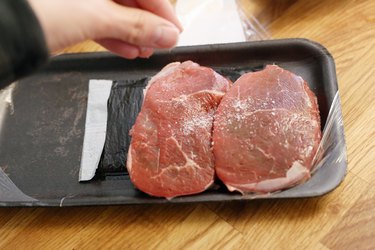
With its beefy flavor, shoulder steak is a delicious yet inexpensive option for family meals. Compared to pork steak and other cuts of meat, it's lower in fat and calories. Depending on your preferences, you can grill, braise or broil it and use the leftovers in a multitude of recipes.
Tip
Shoulder steak is tough and should be cooked over low heat. Braise it before cooking it in the oven so that it becomes tender and more flavorful.
Video of the Day
What Is Shoulder Steak?
Also known as English steak or London broil, this cut is about one inch thick and comes from the chuck (shoulder) region. Since the shoulder muscles get a lot of exercise, they're lean and low in fat, but tough. Therefore, it's recommended to braise the meat for a tender steak in the oven.
Video of the Day
According to the Cattlemen's Beef Board and National Cattlemen's Beef Association, this large primal cut is ideal for slow cooking. You can also marinate it for a few hours and then grill it. The beef shoulder is boneless, so it requires little preparation. Each serving (3 ounces) has 150 calories and key nutrients like:
- 24 grams of protein
- 4.9 grams of fat, including 2 grams of saturated fat
- 45 percent of the DV (daily value) of zinc
- 15 percent of the DV of iron
You'll also get large amounts of potassium, selenium, phosphorus, vitamin B12 and other B-complex vitamins. Red meat, including shoulder steak, is rich in high biological value protein and micronutrients, reports a review published in the Proceedings of the Nutrition Society in December 2015. Heme iron, one of its key nutrients, is better absorbed than non-heme iron, which occurs naturally in plant-based foods.
Read more: 15 of the Best Lean Animal Proteins
As the researchers note, protein is more satiating than carbs and fats, leading to improved appetite control. A diet rich in this nutrient can make it easier to slim down and keep off the pounds.
Zinc, another essential nutrient in the beef shoulder, regulates immune function and supports reproductive health, according to the Oregon State University. It also modulates cellular metabolism and plays a key role in gene expression, hormone production and neurotransmission. Due to its high nutritional value, shoulder steak can be a healthy addition to most diets.
Cooking Shoulder Steak Is Easy
Chuck cuts have little fat and a lot of connective tissues, so they tend to be tough. For this reason, you should always cook them over low heat.
Here's one trick: soak the steak in a ginger marinade to make it tender. Ginger contains enzymes that tenderize the meat and increase collagen solubility, according to a February 2016 review in the Journal of Livestock Science.
Marinate the meat for at least one hour before cooking. Next, add a small amount of oil and a half cup to one cup of broth, wine or water to a deep pan. Sprinkle a pinch of salt, pepper and spices over the steak and then slowly brown it on all sides, recommends the National Cattlemen's Association.
Once this step is completed, transfer the steak to an oven preheated at 325 degrees Fahrenheit. Cover with a lid or aluminum foil and cook until the meat becomes tender. Make sure it reaches a minimum internal temperature of 145 F, according to the USDA. Let it rest for three minutes or longer before carving it.
Read more: Double Protein Steak Salad
When cooked at a low temperature, shoulder steak achieves a tender fall-apart texture and a rich beefy flavor. If you're using the oven, it shouldn't take you longer than three or four hours to cook this tough cut. The USDA reports that beef leftovers can be refrigerated for up to four days or stored in the freezer for two or three months.
How you serve the steak matters, too. Potato salad, white rice, fries and other sneaky side dishes can double or triple its calorie count. To keep it diet-friendly, serve it with cauliflower mashed potatoes, green bean salad, oven-dried tomatoes, roasted radishes and other healthy sides everyone will love.
- Cattlemen's Beef Board and National Cattlemen's Beef Association: "Shoulder Steak"
- Proceedings of the Nutrition Society: "The Role of Red Meat in the Diet: Nutrition and Health Benefits"
- Oregon State University: "Zinc"
- Journal of Livestock Science: "Ginger as a Tenderizing Agent for Tough Meats"
- National Cattlemen's Association: "Basics About Beef"
- USDA: "Beef From Farm to Table"